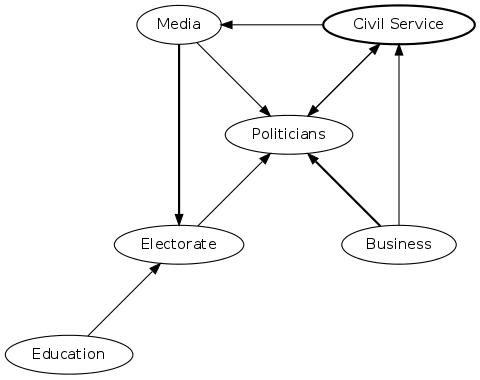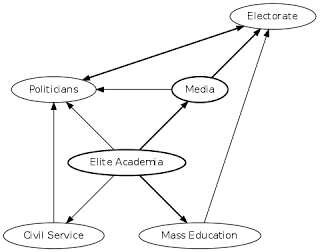Moldbug’s coining “The Cathedral” has caught on and been the subject of much debate, but his other term “The Modern Structure” less so, which is a shame.
The Modern Structure is the constitution of the United States of America, in the sense that that term was originally used — a description of how the government of that country operates. Other Western Democracies have very similar constitutions.
The centre of the Modern Structure is the Civil Service. They actually carry out the business of government.
In theory, they are under the control of Politicians, but in reality the politicians are at most peers of the civil service, and in many cases completely subservient.
In theory again, the Politicians are controlled by the Electorate. However, the influence of the Electorate is slight: enough to tip the balance occasionally when the issue is close, but not to dictate anything. Further, on any issue, the majority of the electorate are completely ignorant, and depend on the media for information about the issue and how they should vote.
Meanwhile, business has at least as much influence on the politicians, and additionally has direct influence on the civil service (through lobbying and other forms of corruption).
In terms of power over government policy, then, the map of influences look something like this:
That is less than half the story, however. In the long run, what matters is not how the noisy controversies of the moment get resolved, but rather what is or is not controversial in the first place. That is the matter of the dominant ideology — what all the people in this network believe about what is and what should be.
The ideology is not fixed: it has changed enormously over mere decades. Who has influence over ideology?
The high status of the organs of the modern structure make them significant, but there are other important influences, and other directions of influence within the network.
This diagram shows the flows of ideological influence. For this purpose I have broken out of “Education” the most crucial organ of ideological influence — “Elite Academia”. This is where ideology comes from.
It is true that, in a sense, everything influences everything else. However, a fully-connected undirected graph has little information content, so the diagram only shows what I think are the biggest influences on what people believe.
I have left out business from the ideology diagram. My view is that while business and lobbyists are able to significantly affect policy, they has very little influence on what people believe. They perhaps have the capability of causing such influence, but in practice businesses are primarily in competition with each other, and it is much more profitable for each player to spend his influence on favouring his own narrow interests rather than on promoting a general business-oriented ideology. To the extent that a business-oriented ideology exists, it is developed by enthusiasts, and funded more by a few eccentrics such as the Kochs rather than by moneyed interests as a whole.
However, this is a disputed point, so here’s the diagram with them added back in, and with the Conservative media broken out from the respectable media.
With or without business interests, it is in the network of ideological influence that we see “The Cathedral” — Elite Academia and Respectable Media — at the core. Ideology flows out from them.
It should go without saying, that this is not intended to be the last word: it is my interpretation of what is mostly general knowledge, and there is a lot of room for refinement, correction and expansion.



It would seem necessary to acknowledge some connection between business and elite academia, in view of the importance of research grants to the academy, and business and mainstream media, in view of the importance of advertising to shaping consumer behavior.
It may also be useful to distinguish between the productive and distributive entities in business, since research grants from industry drive hard science, while finance and foundations tend to make grants to the soft sciences and humanities.
I should have better said "some influence from business to elite academia," I see, since you indeed have influence running from elite academia to business . . .
I see your point, but I'm not sure that's really more significant than the "everything affects everything else" level.
If I was breaking out elite academia in the first diagram, I would show influence from business there. But while donors might get support, or at least silence, in the short term, I don't think they significantly change what academia believes about any issue.
Perhaps the key thing I'm missing in these diagrams is the social grouping. The point about elite academia and the media is that they're the same people, socially. Some of the business group (notably financiers), are largely also the same people. Many politicians too.
Bankers give money to elite academia because they're the same people, believe the same things, and see it as a price of social respectability.
Thanks for the suggestion, anyway.
Hah – literally seconds after writing that last comment, I see this:
"Janet Napolitano, the US Homeland Security Secretary, is to resign from her position to become president of the University of California system"
http://www.telegraph.co.uk/news/worldnews/northamerica/usa/10175540/Where-is-Edward-Snowden-live.html
The social links thing definitely requires further analysis
The social links of key Cathedral priests (and priestesses) has been the precise subject of Scharlach's recent series over at http://habitableworlds.wordpress.com/2013/07/09/profiles-of-cathedral-clerics-2/ . I'd bet he'd appreciate a hand.
Indeed, the differential in influence of elite university graduates (upon every organ of opinion, coverage, and policy) relative to ordinary universities & institutions is probably higher than ever and growing… and likely growing at a higher rate than ever.
I think your visualizations are a good start. One of the things James Goulding would like to see is a thorough description of "how the Cathedral works," and I think this analysis should proceed from both ends, macro and micro. My last couple posts on "Cathedral clerics" has begun the analysis at the individual level, but even if I get 100 profiles up, they will still be a collection of case studies without some macro theorizing about the flow of power, influence, law, and enforcement in the Cathedral.
I don't know why "alvarez80" is popping up here. This is Scharlach. Alvarez is the old handle I used for a couple months when I first started commenting anonymously.
Yes, Marx, Trotsky, Freud, Soros, Friedan, Alinsky, Gould, Boas, Sontag, Chomsky. Very Cathedral-y. Moldbug is not being honest.